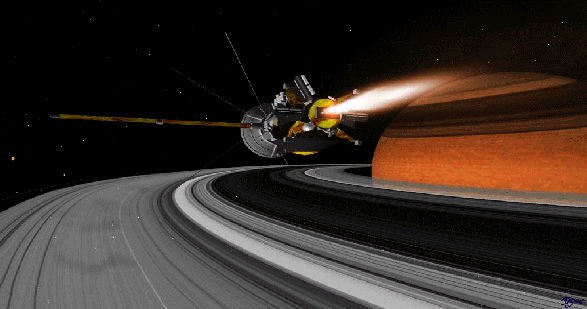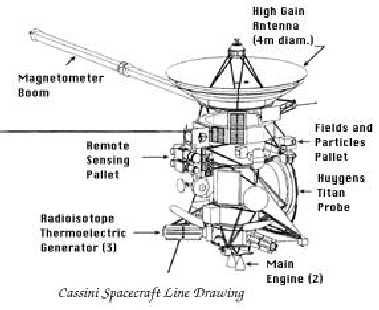

A mission redesign plan advanced by NASA planners that shaved mroe than $200 million dollars off Cassini's total cost managed to convince Congress to continue funding Cassini full to launch under the new scaled down design. Most of the savings came froma complete redesign of the spacecraft that eliminated all deployable structures. This included the moveable scan platform which would have been used to accuratelyl point the cameras and other instruments at their respective targets. As a consequence, eleven of the Cassini instruments are bolted onto the main bus of the spacecraft. Only the magnetomoeter is mounted on a boom away from the spacecraft. The whole spacecraft will have to be moved in order to keep its instruments on target. Cassini will carry more than its share of maneuvering fuel.
Cassini is an international mission, with scientists and universities from the United States and Europe contributing manpower and science experiments. The University of Arizona is heavily involved in this project. Former Voyager project scientist Caroline Porco is among several other scientists from the University of Arizona who are involved with Cassinit's science investigation teams. The Cassini orbiter and Titan IV launcher are being provided by NASA. The European Space Agency is providing the Huygens Titan probe and osme other instruments and hardware for the Cassini orbiter. The mission will be operated and tarcked from NASA's Jet Propulsion Laboratory in Pasadena in Callifornia. Currently, the spacecraft instruments for both Cassini and Huygens are in variable states of fabrication, assembly, and testing. The hardware of both spacecraft are undergoing acoustic testing in preparation for the integration and testing of major of flight subsystems. Full lintegratio nof the spacecraft with its instruments is scheducled to begin in January 1996.
Cassini and Huygens will be mated together atop a Titan IV-Centaur rocket for launch in October 1997. Due to the fact that Cassini and Huygens weigh so much (12,800 pounds) it is impossible to launch the combined spacecraft directly to Saturn. Instead, the spacecraft wil lflly a six year gravity assist trajectory that will take it twice to Venus (April 1998 and June 1999), once back to Earth (August 1999), and on to Jupiter (December 2000) before finally reaching Saturn in June of 2004. Once there, Cassini will be maneuvered into orbit.
Cassini will spend four years observing and studying all aspects of the Saturn system -- specifically, the planet's atmosphere, rings, magnetic field, and moons, with special attention given to Saturn's largest moon, Titan. In addition to the 12 instruments mounted on Cassini, Huygens has an additional 6 instruemtns on board. Some of those instrulments wil lperfomr more than one experiment, bringing the total number of scientific observations to 27.
In late 2004, Cassini will be commanded to jettison the Huygens probe on its three week cruise to Titan. Titan is an important secondary objective for the Cassini/Huygens mission because previous investigations by the Voyager spacecraft revealed that Titan has a thick and opaque atmosphere composed of hydrocarbons and other organic materials believed to have onced made up the atmosphere of Earth before primitive life developed. In additon, crude infrared and radar maps have revealed the possibility of continents and oceans or lakes of liquid hydrocarbons. It is also entirely possible that methane may be raining out of Titan's upper atmosphere. Once Huygens reaches Titan, the craft will descend into the atmosphere. A parachute wil lslow the spacecraft's descent, allowing for pictures and other data to be collected. The data will be relayed to the Cassini orbiter, which will pass by overhead. It is estimated that Huygens will take 3 hours to reach Titan's surface. Scientists do not know if Huygens will hit land surface, or end up splashing in a lake of methane, but they are confident that Huygens will continue to send images and toher compositional data from the surface until the spacecraft's batteries run out of power.
The Cassini orbiter's mission will have only just begun. During its four year observation phase, Cassini will make at least thrity orbits of the Saturn system, each orbit different in period, degree inclination,a nd point of view. Cassini will pass by Titan on nearly every orbit. This is necessary in order for the spacecraft to gravitationally change the inclination of its orbit over its mission lifetime. Cassini wil lalso use a powerful radar mapping instrument similar to waht was used on the Magellan radar mapping mission to Venus to produce radar maps of at least 75% of Titan's surface.
The Cassini mission is expected to end around September 2006. However, is the spacecraft is in good condition, has sufficient maneuvering fuel,and more importantly, if Congress gives NASA the money, then an extended mission will be performed. Even so, Cassini will provide enough information on al laspects of the Saturn system for scientists to analyze for eyars. Cassini will help answer a number of questions about the evolution and creation of life as well as the formation of the solar system. it has been 14 years since we last visitied Saturn's neighborhood. it's time to head back for extended visit.


 |
 |